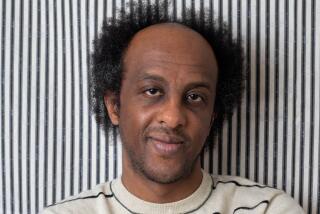In ‘Dinner at the Center of the Earth,’ Nathan Englander deepens and expands what he does so well

Nathan Englander is a fabulist: That’s the first thing to keep in mind. Even when he’s trafficking in the naturalistic — in his story “The Wig” from “For the Relief of Unbearable Urges” or in the magnificent collection “What We Talk About When We Talk About Anne Frank” — he aspires to the lesson of the parable.
“Wouldn’t I hide you?” he writes in the latter, channeling Raymond Carver and the Holocaust. “Even if it was life and death — if it would spare you, and they’d kill me alone for doing it? Wouldn’t I?” That such questions are being asked in the pantry of a suburban house in Florida is the point entirely; we never know where our fables will come from or what form the allegory might take.
A similar sensibility marks “Dinner at the Center of the Earth,” Englander’s second novel (his first, “The Ministry of Special Cases,” came out in 2007): a kaleidoscopic fairy tale of Israeli-Palestinian reconciliation … or its inverse. Shifting fluidly among characters and settings, the book divides its action between 2002 and 2014.
The central character, if we can call him that, is Prisoner Z, a young American Jew-turned-Israeli operative who betrays his mission (or does he?) for a larger cause. That we do not understand, until late in the novel, what this means suggests the complex dance that Z must undergo.
“I’m going to protect my side by trying to fix an imbalance that cannot and should not be maintained,” he informs a Palestinian agent named Farid, whom he has tricked into providing information to facilitate an airstrike on Gaza, but if he believes that this might offer absolution, there is little mercy to be found. “After,” Farid announces in response. “Talk to me then. If you’re going to murder our children, you must be prepared to drink from the same cup of poison.”
One of the exhilarating aspects of ‘Dinner at the Center of the Earth’ is its expansive sense of space and time.
As it turns out, Z will drink from a very different cup of poison; he will be allowed to live. Imprisoned at a black site in the Negev desert, he is erased, held with neither charge nor hearing, his only contact the Israeli guard with whom he forges an amorphous bond. From captivity, he recollects, or (more accurately) the book does: One of the exhilarating aspects of “Dinner at the Center of the Earth” is its expansive sense of space and time.
The novel is constructed as a series of fragments involving Z, yes, but also his Palestinian counterpart, as well as a former general and prime minister of Israel who lies dying in a coma (think Ariel Sharon). “[Y]ou, you raise up the price,” the general recalls, or imagines, being told by David Ben-Gurion. “Don’t stop. Don’t stop until our neighbors get the message. Don’t stop until killing a Jew becomes too expensive for even the rich and profligate man. That is your whole purpose on this earth.”
The decision to base a character on such a specific historical personality is a challenging one, particularly for those who remember Sharon as “[a] murderer, … a butcher,” the architect of massacres in Qibya and Beirut. Englander, however, sidesteps history — or blurs its boundaries — by never referring to the character as anything but the General, rendering him instead as an archetype. The same is true of Prisoner Z, who also goes unnamed throughout the novel, as well as a double agent known mostly as the Waitress, although she is more fully identified toward the end of the book.
The effect is to heighten events, to transcend history in favor of a more allegorical realm. Before his arrest, hiding out in Paris, Z passes “what is known to be the oldest tree” in the city, then moves on to a bookstore that is clearly Shakespeare and Co. before pausing at a fountain there. We read the scene from something of a middle distance, recognizing the location while also kept apart from it, much like the incidents that emerge in the General’s coma reverie.
Englander has built a complex structure, by which his narrative reveals itself in pieces, and the less we know in advance, the more vividly we feel its turns.
As for why this works, it’s in the nature of the fable, in which recognizable figures traverse elusive but also recognizable worlds. More to the point, it is a mechanism of empathy, allowing us to sympathize, or even identify, with the General, a man from whom we might otherwise turn away.
When he recalls, for instance, the shooting death of his young son (based on a tragedy from Sharon’s life), we overlook — for a moment, anyway — his brutal politics and see him as the grieving father he must have been. “He knows, right then,” Englander writes, “for a father to survive this is unthinkable. For him to live even one second after gathering up what cannot be, something is not right. The General holds the boy’s bloody body close and he looks, carefully, around. Yes. Something in his universe has gone awry.”
Awry, indeed — and yet “Dinner at the Center of the Earth” is a fable of a time in which the incomprehensible has become commonplace and we live bound by our degradations rather than our dreams. Just look at Z, who implores the General in a letter: “To lose this war with Palestinians, to cede ground, to raise the white flag of surrender — it is the only way for us to win.”
For this, the sin of renunciation, he is condemned to a living death not unlike that of his correspondent, removed from, and with no hope of returning to, the world. “He had understood,” Englander tells us, “that what he’d imagined as some sort of finish was only the beginning, the unfading start.” At the same time, the fabulist insists, there must be a gesture, a way to recast or rethink.
Here is where the reconciliation asserts itself — through a variety of scenes and situations. In one, the General meets, informally and in secret, with Yasser Arafat. “My favorite enemy,” he tells his aide, Ruthi, “has stopped by for a chat.” Other such moments involve Prisoner Z, as well as the Waitress, but I don’t want to spoil the secrets of the novel; Englander has built a complex structure, by which his narrative reveals itself in pieces, and the less we know in advance, the more vividly we feel its turns. I am reminded of his story “The Tumblers,” in which a community of Jews deported by the Nazis board the wrong train and pose as acrobats until they are (as they must be) revealed.
Something of the same sort of movement takes place here, involving the tunnels between Israel and Gaza (the “center of the earth” of the book’s title), and the primacy of personal, as opposed to patriotic, love. If this feels a little forced in places, well, that too is in the nature of the fable, which is a story in the service of a moral, after all. This has been Englander’s intent from the beginning, and with this novel he articulates and expands on such a sensibility, framing history as both an act and a failure of the imagination, which is to say, in inherently, and inescapably, human terms.
Ulin is the author of “Sidewalking: Coming to Terms With Los Angeles.” A 2015 Guggenheim fellow, he is a former book editor and book critic of the Los Angeles Times.
“Dinner at the Center of the Earth”
Nathan Englander
Knopf: 272 pp., $26.95
More to Read
Sign up for our Book Club newsletter
Get the latest news, events and more from the Los Angeles Times Book Club, and help us get L.A. reading and talking.
You may occasionally receive promotional content from the Los Angeles Times.









